Chapter 5 | Geography | 8th Social Science - Major Hazards in India | 8th Social Science : Geography : Chapter 5 : Hazards
Chapter: 8th Social Science : Geography : Chapter 5 : Hazards
Major Hazards in India
Major Hazards in India:
1. Earthquakes
Earthquake is a violent tremor in
the earth’s crust, sending out a series of shock waves in all directions from
its place of origin.
Earthquake prone regions of the
country have been identified on the basis of scientific inputs relating to
seismicity, earthquakes occurred in the past and tectonic setup of the region.
Based on these inputs, Bureau of Indian Standards has grouped the country into
four seismic zones: Zone II, Zone III, Zone IV and Zone V (No area of India is
classified as Zone I).

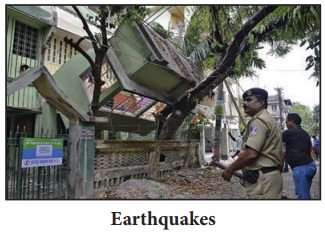
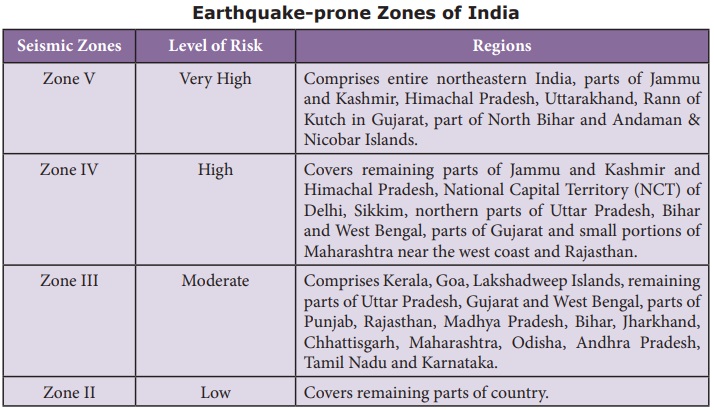
2. Floods
Flood is an event in which a part of
the earth’s surface gets inundated. Heavy rainfall and large waves in seas are
the common causes of flood.
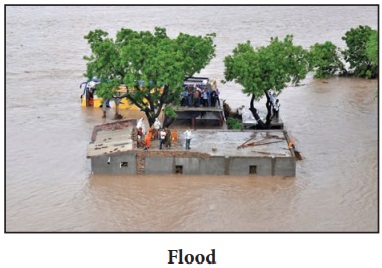
The major causes of floods are:
A.
Meteorological factors
i)
Heavy rainfall
ii)
Tropical cyclones
iii)
Cloud burst
B.
Physical factors
i)
Large catchment area
ii)
Inadequate drainage arrangement
C. Human factors
i)
Deforestation
ii)
Siltation
iii)
Faulty agricultural practices
iv)
Faulty irrigation practices
v)
Collapse of dams
vi) Accelerated urbanization
ACTIVITY : Discuss in the classroom about the actions to
be taken before, during and after flood.
The following map shows the major
flood prone areas in India. Gangetic plains covering the states of Punjab,
Haryana, Uttar Pradesh, North Bihar, West Bengal and Brahmaputra valley are the
major flood prone areas in north and northeast India. Coastal Andhra Pradesh,
Odisha and southern Gujarat are the other regions which are also prone to flood
often.
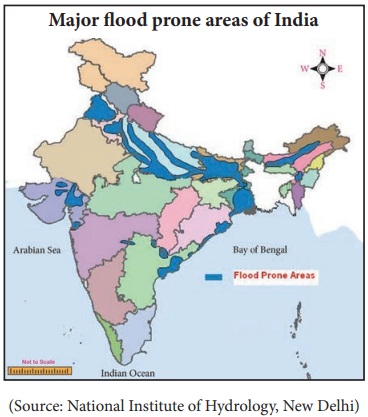
3. Cyclonic Storms
A cyclonic storm is a strong wind
circulating around a low pressure area in the atmosphere. It rotates in anti-clockwise
direction in Northern Hemisphere and clockwise in the Southern Hemisphere.
Tropical cyclones are characterised
by destructive winds, storm surges and exceptional levels of rainfall, which
may cause flooding. Wind speed may reach upto 200 km/h and rainfall may record
upto 50 cm/day for several consecutive days.
A sudden rise of seawater due to
tropical cyclone is called storm surge. It is more common in the regions of
shallow coastal water.
East coastal areas vulnerable to storm surges
i) North Odisha and West Bengal
coasts.
ii)
Andhra Pradesh coast between Ongole and Machilipatnam.
iii) Tamil Nadu coast (among 13
coastal districts, Nagapattinam and Cuddalore districts are frequently
affected).
West coastal areas vulnerable to storm surges
The west coast of India is less
vulnerable to storm surges than the east coast.
1. Maharashtra coast, north of
Harnai and adjoining south Gujarat coast and the coastal belt around the Gulf
of Cambay.
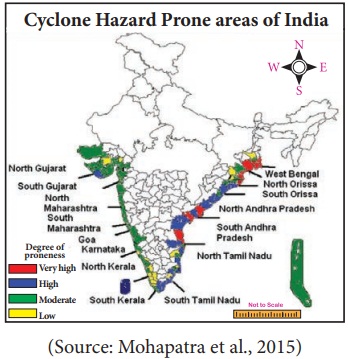
4. Droughts
Any lack of water to satisfy the
normal needs of agriculture, livestock, industry or human population may be
termed as a drought. Further, the drought could be classified into three major
types as,
i.
Meteorological drought: it is a
situation where there is a reduction
in rainfall for a specific period below a specific level.
ii. Hydrological drought: it is associated with reduction of water in streams, rivers
and reservoirs. It is of two types, a) Surface water drought, and b)
Groundwater drought.
iii. Agricultural drought: it refers to the condition in which the agricultural crops get affected due to lack
of rainfall.
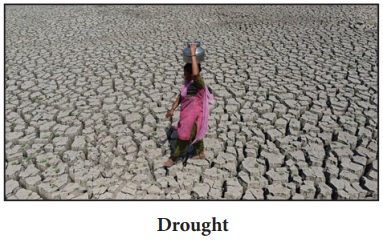
Droughts in India occur in the event of a failure of monsoon. Generally monsoon rainfall is uneven in India. Some areas receive heavy rainfall while other regions get moderate to low rainfall. The areas which experience low to very low rainfall are affected by drought.
Fact
About one third area
of the country is affected by drought. It severely affects 16% of the land area
and 12% of the total population of India. The areas that receive an annual
rainfall of less than 60 cm are the drought prone regions of India.

The major areas highly prone to
drought are:
1.
The arid and semi-arid region from Ahmedabad to Kanpur on one side and from
Kanpur to Jalandhar on the other.
2.
The dry region lying in the leeward side of the Western Ghats.
5.
Landslides
Landslide is a rapid downward
movement of rock, soil and vegetation down the slope under the influence of
gravity. Landslides are generally sudden and infrequent. Presence of steep
slope and heavy rainfall are the major causes of landslides. Weak ground
structure, deforestation, earthquakes, volcanic eruptions, mining, construction
of roads and railways over the mountains are the other causes of landslides.
About 15% of India’s landmass is
prone to landslide hazard. Landslides are very common along the steep slopes of
the Himalayas, the Western Ghats and along the river valleys. In Tamil Nadu,
Kodaikanal (Dindigul district) and Ooty (The Nilgiris district) are frequently
affected by landslides.
6. Tsunami
Tsunami refers to huge ocean waves
caused by an earthquake, landslide or volcanic eruption. It is generally
noticed in the coastal regions and travel between 640 and 960 km/h. Tsunami
pose serious danger to the inhabitants of the coastal areas.
The word ‘Tsunami’ is derived
from Japanese word ‘tsu’ meaning harbour and ‘nami’ meaning wave (Harbour
wave).
Indian Ocean Tsunami of 2004
* On December 26,
2004, at 7:59 a.m. local time, an undersea earthquake with a magnitude of 9.1
struck off the coast of the Indonesian island of Sumatra.
*The tsunami killed at
least 2,25,000 people across a dozen countries, with Indonesia, Sri Lanka,
India, Thailand, Somalia and Maldives, sustaining massive damage.
7. Hazardous Wastes
The wastes that may or tend to cause
adverse health effects on the ecosystem and human beings are called hazardous
wastes.The following are the major hazardous wastes
i. Radioactive substance: tools and unused fuel pipe of nuclear power plants.
ii. Chemicals: synthetic organics, inorganic metals, salts, acids and bases, and
flammables and explosives.
iii. Medical wastes: hypodermic needles, bandages and outdated drugs.
iv. Flammable wastes: organic solvents, oils,
plasticisers and organic sludges.
v. Explosives: the wastes resulting from ordnance manufacturing and some industrial
gases.
vi. Household hazardous wastes: pesticides, waste oil, automobile battery and household battery.
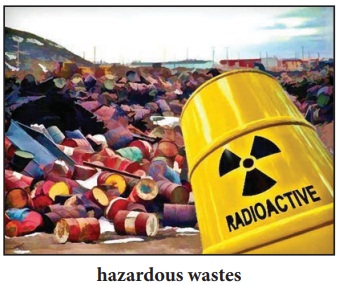
Chernobyl nuclear disaster site (near Pripyat)
to become an official tourist spot
Before:
* Chernobyl (then
Soviet Union) nuclear accident was happened on 26th April, 1986.
* The radiation
emitted was more than 400 times than that released by the atomic bomb dropped
on Hiroshima (Japan) in 1945. This accident remains the largest nuclear
accident in history.
* More than 3,50,000
people were evacuated from the area and severe restrictions on permanent human
settlement are still in that place.
Now:
* 33 years after the
accident, the Exclusion Zone, which covers an area now in Ukraine and Belarus
is inhabited by numerous animals and more than 200 bird species.
* In 2016, the Ukraine
part of this zone was declared as a radiological and environmental biosphere
reserve by the government.
8. Pollution of Air
Air is a mixture of several gases.
The main gases are nitrogen (78.09%) for forming products such as, fertilisers
for plants and for making the air inert, oxygen (20.95%) for breathing and
carbon dioxide (0.03%) for photosynthesis. Some other gases like argon, neon,
helium, krypton, hydrogen, ozone, zenon and methane are also present. Besides,
water vapour and dust particles make their presence felt in one way or the
other.
Air pollution is the contamination
of the indoor or outdoor air by a range of gases and solids that modify its
natural characteristics and percentage. Air pollutants can be categorised into
primary and secondary pollutants.
A primary pollutant is an air pollutant emitted directly from a
source. A secondary pollutant is not directly emitted as
such, but forms when other
pollutants (primary pollutants) react in the atmosphere.
Primary Pollutants
i.
Oxides of Sulphur
ii.
Oxides of Nitrogen
iii.
Oxides of Carbon
iv.
Particulate Matter
v.
Other Primary Pollutants
Secondary Pollutants
i.
Ground Level Ozone
ii. Smog
9. Pollution of Water
Water pollution may be defined as
alteration in the physical, chemical and biological characteristics of water,
which may cause harmful effects in human and aquatic life.
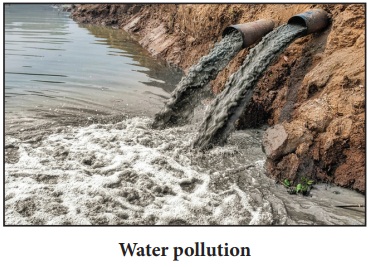
In India, water pollution has been
taking place on a large scale and since a long period. Both surface and
groundwater bodies are polluted to a great extent. The major causes of water
pollution in India are:
i)
Urbanisation
ii) Industrial
effluents
iii)
Sewages
iv)Agricultural
runoff and improper agricultural practices
v) Seawater
intrusion
vi) Solid
wastes
Related Topics